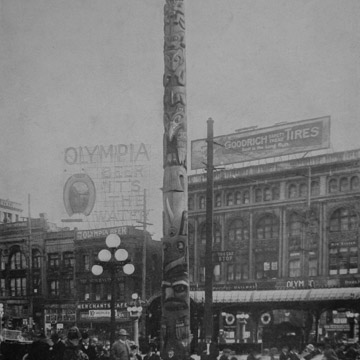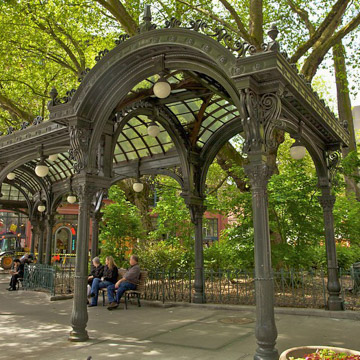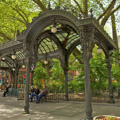Pioneer Square
The area around Pioneer Place (now Pioneer Square) was the city’s first site for civic gatherings. Informally, the location was first known as Occidental Place, in recognition of the former Occidental Hotel that long occupied the site of the current parking garage at Second Avenue and James Street. This was the intersection of Mill (now Yesler Way), James, and Front (now First Avenue) streets, which was perhaps the most spacious intersection in Seattle prior to 1889.
After a fire on June 6, 1889, the City widened Front Street by 18 feet (9 feet on either side) and extended the alignment of Commercial Street (now First Avenue South) to intersect with Front Street almost a block north of Mill Street. This created a triangular plot of land, which the City wanted unencumbered with private improvements. Henry Yesler objected to the condemnation procedure, and eventually received $125,000 for the “Yesler corner,” which ultimately became Pioneer Place, as well as an additional $10,000 for other condemned properties. As a result of the litigation, Yesler did not receive his money from the City until June 1892, less than six months before his death. Upon receipt of payment, Yesler provided the City with a deed to the property, making Pioneer Place the first city park acquired by eminent domain.
Initially, Pioneer Place consisted merely of grass, a small circle of flowers, curbing, and a sidewalk along Mill Street. This changed in 1899, when a group of Seattle businessmen on a tour of southern Alaska stopped in Tongass and decided to bring back to Seattle a totem pole that they had admired. This souvenir was later erected in Pioneer Place with an official dedication on October 18, 1899. The native Alaskans in Tongass were not happy with the theft of their totem pole, which had been erected as a memorial to one of the village’s ancestors and represented the legend of Raven bringing light to the world; however, the totem pole remained in Seattle, becoming a cherished icon for the city, and the sponsors of the trip to Alaska were fined for their misappropriation of native Alaskan art.
A decade later, as part of Seattle’s celebration of its economic connections with Alaska, Canada, and the Pacific Rim, an underground comfort station and cast-iron shelter or pergola was erected. Although a public comfort station in Pioneer Place had been suggested as early as 1906, objections to actually building one did not occur until after the design by Everett and Baker had been accepted in early 1909. These objections delayed awarding of the construction contract to Thomas F. Flynn until the end of April, with the expectation of completion by mid-July. Unexpected construction problems further delayed its completion until November 1909, by which time the Alaska-Yukon-Pacific Exposition had closed. Completion of the cast-iron pergola above the comfort station did not occur until early January 1910.
Another project connected with the Alaska-Yukon-Pacific Exposition was the Chief Seattle Fountain (1909) by James Wehn. This was originally intended as a watering trough/fountain for dogs, horses, and people. Wehn was working at the time on a full-height sculpture of Chief Seattle (also known as Chief Sealth) for another project, and the head of the Street and Sewer Department asked Wehn to provide a bust based upon the larger sculpture for inclusion on the trough/fountain, making this the first sculpture in Seattle to commemorate the Native American chief for whom the city is named.
In October 1938 a fire damaged the totem pole, after which it was discovered that the pole had developed sufficient rot to justify its removal. Through the auspices of the U.S. Forest Service, arrangements for a replica were made; Tlingit carvers replaced the poorly repaired beak of the raven with an authentic version and the colors were applied in the traditional Tligit manner rather than the previous paint.
After the Pioneer Square-Skid Road National Historic District was established in 1970, Jones and Jones were commissioned to rehabilitate the park as the district’s centerpiece. The park’s boundaries enlarged with the removal of vehicular traffic on the east branch of First Avenue; Jones and Jones paved this section with cobblestones. The totem pole and fountain were moved away from First Avenue traffic and the pergola’s glass roof was restored by removing the sheet-metal roofing panels that had replaced previously them. The underground comfort station remained closed to the public as it had for roughly a quarter-century; however, the ornate venting columns that doubled as street lighting were rehabilitated. Most of the $250,000 rehabilitation was funded by James E. Casey, founder of United Parcel Service, who donated $150,000 to the city. A decade after this rehabilitation, Beck and Baird with Olson/Walker Architects fine-tuned the design of the park to emphasize the historic presence of the totem pole and fountain.
On January 15, 2001, a semi-tractor trailer clipped the pergola while making a turn from Yesler Way to First Avenue, causing its collapse. Reconstruction took about eighteen months. Seidelhuber Iron and Bronze Works repaired or replaced the damaged pergola pieces and erected them elsewhere in the park. Ron Wright provided the design for the new stainless steel structure fitted inside of the hollow cast-iron pieces of the pergola to give it greater structural stability.
References
Finger, John Robert. “Henry L. Yesler’s Seattle Years, 1852-1892.” Ph.D. dissertation, University of Washington, 1968.
Garfield, Viola E. The Seattle Totem Pole. Seattle: University of Washington Press, 1980.
“New Totem Pole Fenced to Keep Vandals Away.” Seattle Times, July 26, 1940.
Rupp, James M. Art in Seattle’s Public Places: An Illustrated Guide. Seattle: University of Washington Press, 1992.
“Special Problems of Comfort Station Design.” Pacific Builder & Engineer, January 29, 1910.
Sunde, Scott. “Pergola pieces are back, fittingly.” Seattle Post-Intelligencer, June 18, 2002.
Writing Credits
If SAH Archipedia has been useful to you, please consider supporting it.
SAH Archipedia tells the story of the United States through its buildings, landscapes, and cities. This freely available resource empowers the public with authoritative knowledge that deepens their understanding and appreciation of the built environment. But the Society of Architectural Historians, which created SAH Archipedia with University of Virginia Press, needs your support to maintain the high-caliber research, writing, photography, cartography, editing, design, and programming that make SAH Archipedia a trusted online resource available to all who value the history of place, heritage tourism, and learning.

















